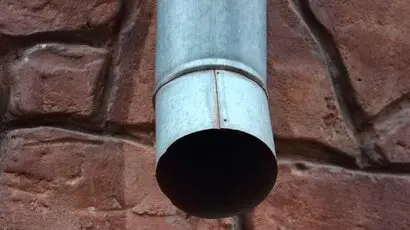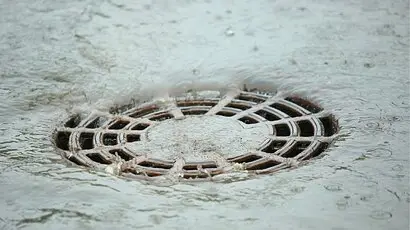DIY Solutions for Clearing Minor Downpipe Blockages
Don’t let blocked downpipes lead to costly water damage in your home. Learn how to identify the signs of a blockage and try our effective DIY clearing methods.
There’s something comforting about the sound of rain on your roof. But if you spot your gutters overflowing or pools of water accumulating near your home after a storm, it might be time to check for blocked downpipes.
Downpipes are crucial for efficiently diverting rainwater away from your home’s foundation. When they become clogged with leaves, twigs, or other debris, water can back up into your gutters and overflow, causing many problems. Water damage can occur to your roof, walls, and even the foundation. Mould growth inside your home becomes a risk; in severe cases, blocked downpipes can even lead to problems with your plumbing.
The good news? You might not need a plumber for minor blockages. With some handy DIY tricks, you can clear blocked downpipes yourself, saving both time and cash. We’ll dive into using a garden hose, baking soda with vinegar, or a simple hot water flush to tackle the problem.
Keeping your gutters clean and installing gutter guards can also be highly effective ways to prevent downpipe blockages from happening in the first place.
A quick look can often tell you if a downpipe’s blocked. Overflowing gutters, even in light rain, are a major clue worth checking. Look for water stains on your exterior walls near the downpipes. Dampness at your house’s foundation is another red flag suggesting drainage issues.
Once you’ve identified a blocked downpipe, the next step is to pinpoint the location of the clog. If water is overflowing from the top of your gutters, the blockage is likely near the gutter outlet or the downpipe’s upper section. However, if your gutters appear clear but no water flows out the bottom of the downpipe, the blockage is likely lower.
Always use a sturdy ladder secured on flat, even ground. Wear thick gloves to protect your hands, and be mindful of any electrical wires around your gutters. If you need help with safely reaching a blockage, it’s best to call a professional.

For minor blockages, you can often tackle the problem yourself with a few household items and some elbow grease. Here are some effective DIY methods to try:
The first step is to see if you can identify the culprit visually. Sometimes, leaves, twigs, or other debris can be lodged at the top of the downpipe opening. If you can safely reach it, you can remove the blockage by hand using thick gloves or long tongs. A flashlight can be helpful to see better inside the downpipe.
If you can’t see anything blocking the opening, a garden hose might be all you need. A strong stream of water can often dislodge blockages located closer to the top of the downpipe. Start with gentle pressure and gradually increase it to avoid damaging the pipe. You can also attach a spray nozzle to your hose for a more targeted approach.
For deeper blockages, a drain rod or plumbing snake is quite handy. These flexible metal rods can manoeuvre through the downpipe bends to break up the clog. When using a drain rod, avoid using too much force to prevent pipe damage. Gently insert it, follow the pipe bends, and rotate to clear any debris.
For greasy or soap scum blockages, a homemade cleaning solution might be worth trying. This method is not suitable for solid debris like leaves or twigs. Pour a cup of baking soda down the downpipe, followed by a cup of vinegar. T
he mixture will fizz and bubble, potentially helping to loosen any greasy build-up. After a few minutes, flush the downpipe with hot water to clear the loosened debris. It’s important to note that this method may be less effective for severe blockages.
Safety is paramount when tackling blocked downpipes, especially if you need to work at heights. Always use a sturdy ladder secured on flat, even ground. Wear thick gloves to protect your hands from sharp objects, and be mindful of any electrical wires around your gutters.
If you’re unsure about safely reaching a blockage or if the DIY methods don’t work, it’s best to call a professional plumber. They have the tools and expertise to safely and effectively clear even the most stubborn blockages.

While DIY methods can be effective for minor blockages, there are times when calling a professional plumber is the best course of action.
If you’ve tried the DIY methods and your downpipe remains blocked, it’s likely the blockage is more extensive. Deeply lodged objects, a large build-up of debris, or even damage to the downpipe itself could be the culprit. In these cases, professional drain cleaning equipment and expertise are needed to safely and effectively clear the blockage.
Safety shouldn’t be an afterthought. Working at heights or near electrical wires carries risks. If you’re unsure about safely accessing the blockage, it’s wise to call in a professional.
The best way to avoid the hassle of blocked downpipes is to prevent them from happening in the first place. Here are some key preventative measures:
Regular gutter cleaning is essential. Scheduling a professional gutter cleaning service at least once or twice a year, particularly before autumn when leaves fall, can significantly reduce the risk of blockages. This will remove any build-up of leaves, twigs, and other debris that could potentially clog your downpipes.

Consider installing downpipe guards. These are mesh filters that fit over the top of your downpipes, preventing leaves and debris from entering the system altogether. Downpipe guards are a great preventative measure, saving you time and effort in the long run.
Finally, keeping overhanging tree branches trimmed can make a big difference. Branches that shed leaves directly into your gutters can be a major source of blockages.
Following these straightforward preventative measures can save you from the hassles of blocked downpipes, ensuring your home’s drainage system runs smoothly.
By following these tips and using a little elbow grease, you can often tackle minor blocked downpipe issues yourself.
For clear advice and expert service, reach out to WP Plumbing, your local blocked drain specialist.
We’ve covered DIY tips and tricks for clearing blocked downpipes, from using a garden hose to baking soda and vinegar. But for stubborn blockages or professional peace of mind, WP Plumbing is here to help. Our qualified plumbers have the tools and expertise to clear any blocked downpipe quickly and efficiently, ensuring your home’s drainage system flows freely all year round. Contact WP Plumbing today for a free quote and keep your house happy and healthy, one clear downpipe at a time!
Sick of blockages in your downpipes?This comprehensive guide explains how to unblock your downpipe, offering easy-to-follow steps and tips to ensure your gutter system functions smoothly and prevents potential issues related to water overflow.
A blocked downpipe can cause serious problems for your home, from roof leaks to damaged walls. If you suspect a blockage, taking action immediately is important. This guide will help you identify the signs of a blocked downpipe and explain what to do next.
Explore the causes and consequences of blocked stormwater drains, including tree roots, garden debris, and incorrect pipe connections. Learn how to detect blockages and implement effective prevention strategies for a healthier drainage system.


